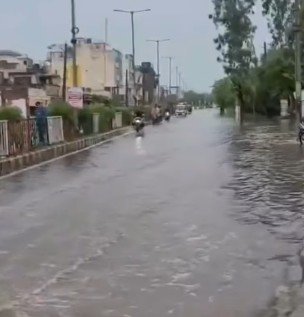Amid an escalating monsoon cycle, the India Meteorological Department (IMD) has issued a flash flood alert for 11 districts in Punjab, warning of high-intensity rainfall, overflowing drains, and sudden water level rises that could endanger lives and disrupt local infrastructure. The warning comes as part of a wider weather advisory covering northwestern India, which is currently witnessing an aggressive surge in monsoonal patterns.
According to the IMD bulletin released on July 4, 2025, the districts most at risk include Amritsar, Gurdaspur, Pathankot, Hoshiarpur, Ludhiana, Jalandhar, Kapurthala, Nawanshahr (SBS Nagar), Rupnagar (Ropar), Mohali, and Fatehgarh Sahib. The department has specifically cautioned residents in low-lying areas, riverbank settlements, and urban centers prone to waterlogging to remain vigilant through the July 5–8 period, when rainfall activity is projected to peak.
The flash flood risk stems from the development of a monsoon trough coupled with a low-pressure area moving across northern India. This system is expected to bring extremely heavy rain, particularly in the Shivalik foothills and the Doaba region. The situation is compounded by saturated soil conditions due to early July showers, which limit the ground’s capacity to absorb additional water.
As a preventive measure, the Punjab government has activated emergency monitoring cells across all affected districts. Deputy Commissioners have been instructed to coordinate with local bodies, irrigation departments, and disaster response teams to ensure 24/7 preparedness. Special arrangements are being made to stock sandbags, deploy mobile water pumps, and identify shelter zones in areas most vulnerable to flooding.
Speaking on the alert, Punjab’s Revenue and Disaster Management Minister Bram Shanker Jimpa urged citizens to avoid unnecessary travel and report signs of rising water levels or blocked drainage systems. “We have mobilized SDRF teams, and our district administrations are fully geared to respond quickly. But the public’s cooperation is vital to prevent loss of life or property,” he said.
In urban pockets such as Ludhiana and Amritsar, civic bodies have begun urgent desilting operations in stormwater drains and sewerage lines. Last year, similar negligence led to paralyzing floods in multiple localities, highlighting the need for pre-monsoon preparedness. Municipal commissioners in these cities have assured residents that this year’s mitigation efforts are being supervised daily.
The Water Resources Department has also raised concern over swelling river levels, particularly in the Beas, Sutlej, and Ravi catchments. Officials have begun releasing controlled water from key reservoirs and have advised fishermen and farmers to steer clear of riverbanks during the red alert period. In areas bordering Himachal Pradesh and Jammu & Kashmir, precautionary evacuation plans are being discussed as a backup response.
Schools in high-alert districts have been given the option to shift to online learning temporarily. Meanwhile, Punjab State Power Corporation Limited (PSPCL) has issued advisories to prevent electrocution incidents and short circuits, which often accompany waterlogging in older localities.
Environment experts have noted that flash floods are becoming more frequent in Punjab due to increased urbanization, poor stormwater management, and climate change-induced shifts in rainfall patterns. “What used to be once-in-five-year flood events are now happening almost every year. It’s time for local governments to redesign their urban planning around climate resilience,” said Dr. Simar Kaur, a hydrologist at Punjab Agricultural University.
While the rain brings relief to parched farmlands and recharges groundwater, its increasing unpredictability has become a double-edged sword for a state heavily reliant on agriculture and already grappling with infrastructural constraints. The coming days will test not only the strength of Punjab’s administrative machinery but also the awareness and resilience of its citizens.
#PunjabFlashFlood #IMDAlert #HeavyRainPunjab #FloodPreparedness #DisasterManagementPunjab #UrbanFlooding #PunjabRainfall #ClimateAlertIndia #SDRFResponse #PunjabMonsoon2025
This is an auto web-generated news web story.





